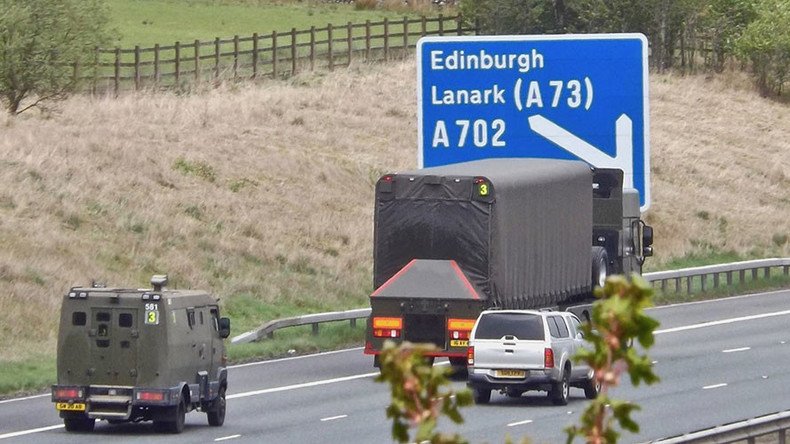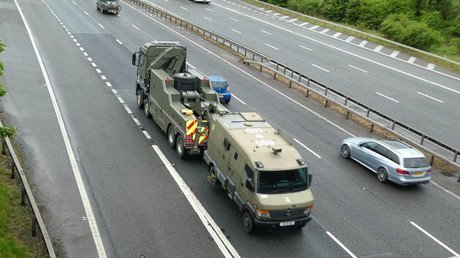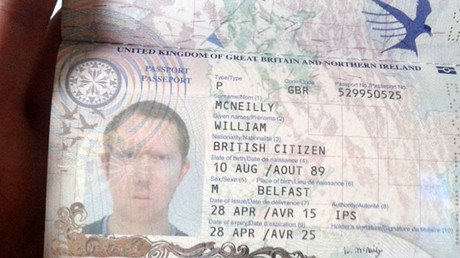Scotland ‘wholly unprepared’ for nuclear weapons accident on its roads – report

Nuclear warheads surrounded by explosives are regularly transported on British roads, yet authorities are “wholly unprepared” to handle an accident, a damning report has revealed.
A “critical gap” in the protection of Britons has been identified by Nukewatch UK, amid claims public safety is being put at risk by the Scottish Government.
The report, ‘Unready Scotland’, reveals weapons of mass destruction (WMDs) are driven across the country around eight times every year, without police accompanying them and without public knowledge.
The convoys travel with a potentially-deadly cocktail of explosives and nuclear weapons packed inside – yet those traveling alongside the huge trucks remain blissfully unaware of the dangerous cargo.
Scottish councils have failed to carry out individual assessments of the routes taken by the massive convoys. This means vital evacuation time could be lost and the number of casualties could rise rapidly should there be an incident.
The potential contamination zone for an accident involving nukes is 24 miles, according to some experts, meaning entire villages and towns could be engulfed.
“The radioactive material in the warheads includes both plutonium and uranium, with a potential dispersal range of at least 5km,” Nuke Watch reports. “In addition to this, warhead materials include a number of toxic and hazardous substances.”
Unready Scotland suggests there is “no evidence” that authorities would be able to cope with a disaster on the route between the Aldermaston and Burghfield atomic weapon plants in Berkshire and RNAD Coulport on Loch Long.
In the event of nuclear fallout, the Ministry of Defence (MoD) would prioritize the mobilization of troops to secure the weapons – and the safety of the public would fall squarely on the shoulders of local authorities and emergency responders.
Yet the frightening report shows that those who would be first on the scene would be “unprepared” and unable to launch into action.
The researchers warn that police, paramedics and the Scottish Government, who would need to handle a mass evacuation, are “wholly unprepared to discharge that responsibility.”
Although some claim an accident involving a convoy is unlikely, there have already been underreported incidents. In May, a military convoy of nuclear warhead carriers was left stranded on the side of the M40 motorway when the escort broke down. Fortunately in this instance there were no live warheads onboard.
Despite authorities claiming potential terrorist plots make it impossible for them to reveal details of the convoys to the public, activists claim the information is already in the public domain.
The report claims there is “no justification for not informing the public about the existence of the convoy traffic and its attendant risks.”
“The simple fact that these trucks carry nuclear bombs on public roads is enough to cause very serious concern, amounting to alarm,” said Nuke Watch. The report says the police officers manning the convoy “very frequently” have no idea what they are protecting – and would be unable to react in an emergency, the report says.
Astonishingly, some authorities “rely on generic risk assessments conducted within their Resilience Partnerships.”
Practice runs have been carried out on a small scale, according to Local Authority and Emergency Services Information (LAESI) reports, but nowhere close to the scale of the potential damage.
In 1990 it was predicted by nuclear engineer John Large that an accident involving nuclear warheads could spread contamination “at least 40 kilometres.”
Nuke Watch has called for an urgent review into the country’s response to a nuclear accident.
It claims since community safety is wholly devolved to the Scottish Parliament at Holyrood, the Scottish National Party (SNP) Government has failed in its duty to put adequate plans in place.
RT has contacted the SNP for comment.














